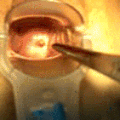Hormonal intrauterine device
A type of long-acting reversible contraceptive device
A hormonal intrauterine device (IUD) is a small, T-shaped plastic device that is inserted into the uterus to provide long-term contraception. It releases a hormone called levonorgestrel, which is a type of progestin. This device is considered a form of long-acting reversible contraception (LARC) and is highly effective in preventing pregnancy.
Mechanism of Action[edit]
The hormonal IUD works primarily by releasing levonorgestrel into the uterine cavity. This hormone thickens the cervical mucus, making it difficult for sperm to enter the uterus and fertilize an egg. Additionally, levonorgestrel thins the endometrium, reducing the likelihood of implantation should fertilization occur. In some cases, it may also inhibit ovulation.
Types of Hormonal IUDs[edit]
There are several types of hormonal IUDs available, varying in size, hormone dosage, and duration of effectiveness. Common brands include:
- Mirena: Effective for up to 7 years, releases 20 micrograms of levonorgestrel per day.
- Kyleena: Effective for up to 5 years, releases 17.5 micrograms of levonorgestrel per day.
- Skyla: Effective for up to 3 years, releases 14 micrograms of levonorgestrel per day.
- Liletta: Effective for up to 6 years, releases 19.5 micrograms of levonorgestrel per day.
Insertion and Removal[edit]
The insertion of a hormonal IUD is a procedure typically performed by a healthcare professional. It involves placing the device through the cervix into the uterus. The procedure can cause discomfort, but it is usually brief. Removal is also performed by a healthcare provider and involves gently pulling on the IUD strings to extract the device from the uterus.
Benefits[edit]
Hormonal IUDs offer several benefits, including:
- High effectiveness in preventing pregnancy (over 99%).
- Long-term protection, ranging from 3 to 7 years depending on the type.
- Reduction in menstrual bleeding and dysmenorrhea (painful periods).
- Rapid return to fertility upon removal.
Side Effects[edit]
Some users may experience side effects, particularly in the first few months after insertion. These can include:
- Irregular bleeding or spotting.
- Headaches.
- Breast tenderness.
- Mood changes.
- Ovarian cysts.
Contraindications[edit]
Hormonal IUDs are not suitable for everyone. Contraindications include:
- Current pelvic inflammatory disease (PID).
- Known or suspected breast cancer.
- Unexplained vaginal bleeding.
- Severe liver disease.
Gallery[edit]
-
Hormonal intrauterine device
-
Hormonal intrauterine device
-
Hormonal intrauterine device
-
Hormonal intrauterine device
-
Hormonal intrauterine device
-
Hormonal intrauterine device
-
Hormonal intrauterine device
Related Pages[edit]
Ad. Transform your life with W8MD's Budget GLP-1 injections from $75


W8MD offers a medical weight loss program to lose weight in Philadelphia. Our physician-supervised medical weight loss provides:
- Weight loss injections in NYC (generic and brand names):
- Zepbound / Mounjaro, Wegovy / Ozempic, Saxenda
- Most insurances accepted or discounted self-pay rates. We will obtain insurance prior authorizations if needed.
- Generic GLP1 weight loss injections from $75 for the starting dose.
- Also offer prescription weight loss medications including Phentermine, Qsymia, Diethylpropion, Contrave etc.
NYC weight loss doctor appointmentsNYC weight loss doctor appointments
Start your NYC weight loss journey today at our NYC medical weight loss and Philadelphia medical weight loss clinics.
- Call 718-946-5500 to lose weight in NYC or for medical weight loss in Philadelphia 215-676-2334.
- Tags:NYC medical weight loss, Philadelphia lose weight Zepbound NYC, Budget GLP1 weight loss injections, Wegovy Philadelphia, Wegovy NYC, Philadelphia medical weight loss, Brookly weight loss and Wegovy NYC
|
WikiMD's Wellness Encyclopedia |
| Let Food Be Thy Medicine Medicine Thy Food - Hippocrates |
Medical Disclaimer: WikiMD is not a substitute for professional medical advice. The information on WikiMD is provided as an information resource only, may be incorrect, outdated or misleading, and is not to be used or relied on for any diagnostic or treatment purposes. Please consult your health care provider before making any healthcare decisions or for guidance about a specific medical condition. WikiMD expressly disclaims responsibility, and shall have no liability, for any damages, loss, injury, or liability whatsoever suffered as a result of your reliance on the information contained in this site. By visiting this site you agree to the foregoing terms and conditions, which may from time to time be changed or supplemented by WikiMD. If you do not agree to the foregoing terms and conditions, you should not enter or use this site. See full disclaimer.
Credits:Most images are courtesy of Wikimedia commons, and templates, categories Wikipedia, licensed under CC BY SA or similar.
Translate this page: - East Asian
中文,
日本,
한국어,
South Asian
हिन्दी,
தமிழ்,
తెలుగు,
Urdu,
ಕನ್ನಡ,
Southeast Asian
Indonesian,
Vietnamese,
Thai,
မြန်မာဘာသာ,
বাংলা
European
español,
Deutsch,
français,
Greek,
português do Brasil,
polski,
română,
русский,
Nederlands,
norsk,
svenska,
suomi,
Italian
Middle Eastern & African
عربى,
Turkish,
Persian,
Hebrew,
Afrikaans,
isiZulu,
Kiswahili,
Other
Bulgarian,
Hungarian,
Czech,
Swedish,
മലയാളം,
मराठी,
ਪੰਜਾਬੀ,
ગુજરાતી,
Portuguese,
Ukrainian






